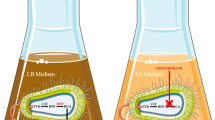Abstract
The genetic activity of several medical grades of the anthelmintic drug pyrvinium pamoate, which is a dipyrvinium salt, was studied in a diploid mitotic recombination and gene conversion assay (strain D5 ofSaccharomyces cerevisiae), and in several haploid yeast reversion assays (strains XV185-14C, XY718-1A, and 7854-1A). All of the samples were recombinogenic in strain D5 and mutagenic in the haploid strains, however, the degree of genetic activity varied considerably among the medical grades of pyrvinium pamoate that were tested. Similarly, these samples varied in degree of mutagenicity when they were tested in strains TA97, TA98, TA100, and TA102 ofSalmonella typhimurium, but some of the medical grades of pyrvinium pamoate were mutagenic both in the presence and in the absence of the metabolic transformation system, whereas other medical grades of the drug required such activation to be mutagenic. In addition, the medical grades and dosage forms of several brands of pyrvinium pamoate were examined for purity by fluorescence high pressure liquid chromatography (HPLC) using a methanol:water (90∶10) solvent system. The HPLC data indicate that monopyrvinium salts are the major contaminants in these pharmaceuticals. In general, there is a correlation between the degree of genetic activity and toxicity, and the number and relative quantity of impurities found in each sample.
Similar content being viewed by others
References
Ames BN, McCann J, Yamasaki E (1975) Method for detecting carcinogens and mutagens with the Salmonella/mammalian microsome mutagenicity test. Mutat Res 31: 347–363
Beckstead HD, Smith SJ (1967) Improved method of assay of pyrvinium pamoate and its official preparations. J Pharm Sci 56: 390–393
Callen DF, Philpot RM (1977) Cytochrome P-450 and the activation of promutagens inSaccharomyces cerevisiae. Mutat Res 45: 309–324
Cortinas de Nava C, Espinosa J, Garcia L, Zapata AM, Martinez E (1983) Mutagenicity of antiamebic and anthelmintic drugs in theSalmonella typhimurium microsomal test system. Mutat Res 117: 79–91
Culbertson MR, Charnas L, Johnson MT, Fink GR (1977) Frameshifts and frameshift suppressors inSaccharomyces cerevisiae. Genetics 86: 745–764
de la Iglesia FA, Lake RS, Fitzgerald JE, Bueding E, Brusick D (1984) Bacterial mutagenesis and cell transformation assays of pyrvinium pamoate (Povan), an antiparasitic agent. J Am Coll Toxicol 3: 285–294
Galindo OC (1979) Estudio de la capacidad mutagenica de medicamentos antiparasitarios enSaccharomyces cerevisiae. Tesis Profesional, Universidad Nacional Autonoma de Mexico
Galindo OC, Cortinas de Nava C, Savage EA, Mehta RD, von Borstel RC (1979) Mutagenicity of the antihelminthic compound Vanquin in the 14C Saccharomyces reversion assay. Environ Mutagen 1: 185
Hales DR, Welch AD (1953) A preliminary study of the anthelmintic activity of cyanine dye #715 in dogs. J Pharmacol Exp Ther 107: 310–314
Hennig UGG, Mehta RD, von Borstel RC, Chatten LG (1981) Chemical impurities and the degree of mutagenicity of medical grades of pyrvinium pamoate inSaccharomyces cerevisiae. Environ Mutagen 3: 380
Lake RS, de la Iglesia FA (1981) Genotoxicity evaluation of pyrvinium pamoate. Environ Mutagen 3: 336
MacPhee DG, Podger DM (1977) Mutagenicity tests on anthelmintics: Microsomal activation of viprynium embonate to a mutagen. Mutat Res 48: 307–312
Maron DM, Ames BN (1983) Revised methods for the Salmonella mutagenicity test. Mutat Res 113: 173–215
Mehta RD, Hennig UGG, von Borstel RC, Chatten LG (1982) Genetic activity inSaccharomyces cerevisiae and thin-layer chromatographic comparisons of medical grades of pyrvinium pamoate and monopyrvinium salts. Mutat Res 102: 59–69
Rollo IM (1980) Chemotherapy of parasitic diseases: Drugs used in the chemotherapy of helminthiasis. In: Gilman AG, Goodman LS, Gilman A (eds) The pharmacological basis of therapeutics. Macmillan, New York, pp 1013–1037
Swinyard EA (1985) Parasiticides. In: Gennaro AR (ed) Remington's pharmaceutical sciences (17th edn). Mack Publishing Company, Easton, Pennsylvania, pp 1234–1240
Swinyard EA, Harvey SC (1970) Parasiticides: Anthelmintics — pediculicides and scabicides. In: Osol A (ed) Remington's pharmaceutical sciences (14th edn). Mack Publishing Company, Easton, Pennsylvania, pp 1264–1273
The Medical Letter (1986) Drugs for parasitic infections. Med Lett Drugs Ther 28: 9–18
USP XX (1980) Official monographs: Pyrvinium pamoate. In: The United States Pharmacopeial Convention Inc (eds) The United States Pharmacopeia XX/National Formulary XV. Mack Publishing Company, Easton, Pennsylvania, pp 696–697
von Borstel RC, Cain KT, Steinberg CM (1971) Inheritance of spontaneous mutability in yeast. Genetics 69: 17–27
von Borstel RC, Quah S-K, Steinberg CM, Flury F, Gottlieb DJC (1973) Mutants of yeast with enhanced spontaneous mutation rates. Genetics (Suppl) 73: 141–151
Weston JK, Thompson PE, Reinertson JW, Fisken RA, Reutner TF (1953) Antioxyurid activity, toxicology and pathology in laboratory animals of a cyanine dye [6-dimethylamino-2-[2-(2,5-dimethyl-1-phenyl-3-pyrryl)vinyl]-1-methylquinolinium chloride]. J Pharmacol Exp Ther 107: 315–324
Zimmermann FK (1973) A yeast strain for visual screening for the two reciprocal products of mitotic crossing over. Mutat Res 21: 263–269
Author information
Authors and Affiliations
Rights and permissions
About this article
Cite this article
Hennig, U.G.G., Chatten, L.G., Pon, R.A. et al. The detection of chemical impurities by high pressure liquid chromatography and the genetic activity of medical grades of pyrvinium pamoate inSaccharomyces cerevisiae andSalmonella typhimurium . Arch Toxicol 60, 278–286 (1987). https://doi.org/10.1007/BF01234666
Received:
Accepted:
Issue Date:
DOI: https://doi.org/10.1007/BF01234666




